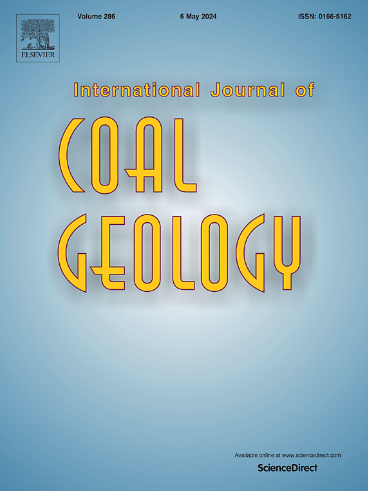Occurrences of paleo-wildfires in the early Albian, Erlian Basin, NE China: Evidence from coal petrography and geochemistry
IF 5.7
2区 工程技术
Q2 ENERGY & FUELS
引用次数: 0
Abstract
The Albian in the early Cretaceous was a period with extensive and frequent wildfires, yet the wildfire types, intensity, and implications are not well understood due to the lack of continuous wildfire records. In this study, a total of 79 coal samples were collected from a 13 m thick coal seam in the early Cretaceous in the Erlian Basin, Inner Mongolia, China, which were analyzed using Zircon U![]() Pb dating, coal petrography analysis, scanning electron microscopy, and gas chromatography–mass spectrometry techniques. Zircon dating of an interbedded volcanic ash layer shows the coal was deposited in the early Albian, at 111.14 ± 1.14 Ma. Petrographic and proximate analysis show that the coals are characterized by mainly huminite (18.7–84.2 vol%, average 52.7 vol%, mmf—mineral matter free) and inertinite (15.1–80.7 vol%, average 46.2 vol%, mmf), with high volatile matter yields (average 39.7 %, dry and ash-free basis) and low ash yields (average 7.45 %, air dry basis). The frequent wildfire events are recognized by: (1) the inertinite content, mostly composed of fusinite, semifusinite, and inertodetrinite, and higher than most of the reported inertinite contents in the other Cretaceous coals around the world; (2) inertinite, representative of fossil charcoal is typified by homogenized cell walls and vesicles generated under high temperature; and (3) the polycyclic aromatic hydrocarbons (PAHs) are composed of 16 types of 2–6 ring aromatic hydrocarbon compounds, with the average pyrogenic PAHs accounting for 73.9 % of the total PAHs and the medium and high-molecular-weight PAHs accounting for 70.6 % of total molecular-weight PAHs. The average inertinite reflectance values range between 0.86 % and 1.60 %, with an average of 1.21 %, reflecting the fire temperature values ranging from 230 to 436 °C, with an average of 327 °C. The main wildfire types were ground and surface fires under low to moderate temperatures, and wildfire intensity variation was shown by the total content of fusinite and semifusinite, pyrogenic PAHs concentrations, and inertinite reflectance of the coals. Maceral and mineral matter composition indicated that the coals were formed under wet moor with intermittent moderate to high flooding. The peat in topogenous and ombrotrophic raised mires is evidenced by the presence of tonstein and a low ash yield. Changes in fire types and intensity in the Erlian Basin provide new evidence that the Albian is a unique “high fire” period within the Cretaceous.
Pb dating, coal petrography analysis, scanning electron microscopy, and gas chromatography–mass spectrometry techniques. Zircon dating of an interbedded volcanic ash layer shows the coal was deposited in the early Albian, at 111.14 ± 1.14 Ma. Petrographic and proximate analysis show that the coals are characterized by mainly huminite (18.7–84.2 vol%, average 52.7 vol%, mmf—mineral matter free) and inertinite (15.1–80.7 vol%, average 46.2 vol%, mmf), with high volatile matter yields (average 39.7 %, dry and ash-free basis) and low ash yields (average 7.45 %, air dry basis). The frequent wildfire events are recognized by: (1) the inertinite content, mostly composed of fusinite, semifusinite, and inertodetrinite, and higher than most of the reported inertinite contents in the other Cretaceous coals around the world; (2) inertinite, representative of fossil charcoal is typified by homogenized cell walls and vesicles generated under high temperature; and (3) the polycyclic aromatic hydrocarbons (PAHs) are composed of 16 types of 2–6 ring aromatic hydrocarbon compounds, with the average pyrogenic PAHs accounting for 73.9 % of the total PAHs and the medium and high-molecular-weight PAHs accounting for 70.6 % of total molecular-weight PAHs. The average inertinite reflectance values range between 0.86 % and 1.60 %, with an average of 1.21 %, reflecting the fire temperature values ranging from 230 to 436 °C, with an average of 327 °C. The main wildfire types were ground and surface fires under low to moderate temperatures, and wildfire intensity variation was shown by the total content of fusinite and semifusinite, pyrogenic PAHs concentrations, and inertinite reflectance of the coals. Maceral and mineral matter composition indicated that the coals were formed under wet moor with intermittent moderate to high flooding. The peat in topogenous and ombrotrophic raised mires is evidenced by the presence of tonstein and a low ash yield. Changes in fire types and intensity in the Erlian Basin provide new evidence that the Albian is a unique “high fire” period within the Cretaceous.
中国东北二连盆地早白垩世古野火的发生:来自煤岩相学和地球化学的证据
早白垩世的白垩纪是一个野火广泛而频繁的时期,但由于缺乏连续的野火记录,人们对野火的类型、强度和影响还不甚了解。本研究从中国内蒙古二连盆地早白垩世13米厚的煤层中采集了79个煤样,采用锆石UPb测年、煤岩相分析、扫描电子显微镜和气相色谱-质谱联用技术进行了分析。对夹层火山灰层进行的锆石定年显示,煤炭沉积于早阿尔卑斯时期,时间为 111.14 ± 1.14 Ma。岩相和近物性分析表明,煤炭的主要特征是腐植质(18.7-84.2 vol%,平均 52.7 vol%,mmf-不含矿物物质)和惰性质(15.1-80.7 vol%,平均 46.2 vol%,mmf),挥发物含量高(平均 39.7%,干燥和无灰分),灰分含量低(平均 7.45%,气干)。频繁的野火事件可通过以下方面识别(1)惰性石英含量,主要由富石英、半富石英和惰性铁石英组成,高于世界上其他白垩纪煤炭中的惰性石英含量;(3) 多环芳烃(PAHs)由 16 种 2-6 环芳烃化合物组成,其中热成多环芳烃平均占 PAHs 总量的 73.9 %,中高分子量多环芳烃占总分子量多环芳烃的 70.6 %。惰性系数的平均反射率在 0.86 % 到 1.60 % 之间,平均为 1.21 %,反映出火灾温度值在 230 ℃ 到 436 ℃ 之间,平均为 327 ℃。主要的野火类型是中低温下的地面火和地表火,野火强度的变化表现在煤炭中的燧石和半燧石总含量、热成多环芳烃浓度和惰性反射率上。宏观矿物和矿物物质组成表明,煤炭是在间歇性中度至高度洪水的湿润荒原下形成的。表生和外生凸起沼泽中的泥炭由碳酸盐和低灰分产率证明。二连盆地火灾类型和强度的变化提供了新的证据,证明阿尔卑斯时期是白垩纪中一个独特的 "高火 "时期。
本文章由计算机程序翻译,如有差异,请以英文原文为准。
求助全文
约1分钟内获得全文
求助全文
来源期刊

International Journal of Coal Geology
工程技术-地球科学综合
CiteScore
11.00
自引率
14.30%
发文量
145
审稿时长
38 days
期刊介绍:
The International Journal of Coal Geology deals with fundamental and applied aspects of the geology and petrology of coal, oil/gas source rocks and shale gas resources. The journal aims to advance the exploration, exploitation and utilization of these resources, and to stimulate environmental awareness as well as advancement of engineering for effective resource management.
 求助内容:
求助内容: 应助结果提醒方式:
应助结果提醒方式:


